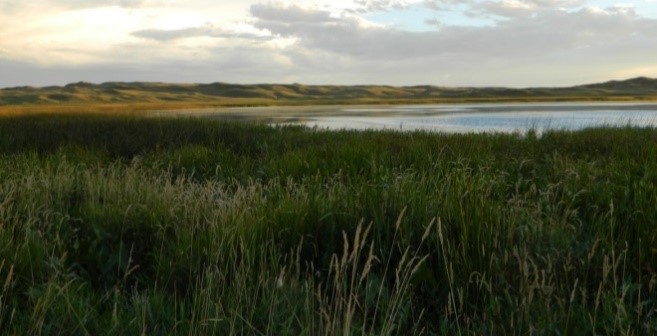
Species
Sandhills Wetland/ Wet Meadow Habitat
Principal biologist(s)
Carter Kruse, Eric Leinonen
Project Location
McMurtrey Ranch, Cherry County, NE
Conservation Problem
Loss of Sandhills wet meadow and wetland habitat due to ditching and draining for hay and grazing production. As much as 40% of Sandhills wetlands lost due to agricultural development.
Project Goals & Objectives
The Sandhills Region of north-central Nebraska encompasses 19,600 square miles of grassland, and contains vast surface and groundwater resources. The grass covered sand dunes of the region act like giant sponges that absorb precipitation, which is then discharged as streams, wetlands, and wet meadows in interdunal valleys. Around 1.3 million acres of wetlands (Figure 14.1), formed by groundwater discharge, are scattered throughout the region, supporting a rich ecological diversity.
Beginning in the early 1900’s, draining and ditching of wetlands and wet meadows became commonplace as ranchers looked to increase grass production and develop hay meadows (Figures 14.2 and 14.3). With drain installation, the hydrologic balance between groundwater and surface wetlands becomes disrupted. With drained wetlands no longer buffering groundwater discharge, a continual flow of water occurs into drains and natural streams. With added flow, channels become incised in the fine soils, capturing more ground water, lowering the local water table and ultimately reducing productivity of the surrounding area. In this way, an around 40% of wetland habitat have been lost to agricultural development.
A Sandhills Task Force (STF), made up of interested and diverse natural resource and ranching stakeholders, was formed in 1990 with a goal “to enhance the sandhill wetland-grassland ecosystem in a way that sustains profitable private ranching, wildlife and vegetation diversity, and associated water supplies” – a goal that mirrors the mission of Turner Enterprises, Inc. One strategy of the STF is to provide technical and financial assistance for improvement and restoration of wetlands, riparian habitat, and upland habitats in the Sandhills. After several months of informal discussions, we partnered with STF in 2014 to restore around 4 km of Gordon Creek to a more natural (prior to ditching and draining) channel alignment and streambed elevation, which will improve or restore approximately 140 ha of associated wetland and wet meadow habitat in the Gordon Creek valley bottom (Figure 14.4). If successfully implemented, this project will be the largest Sandhills stream and associated wetland restoration projected ever completed.
